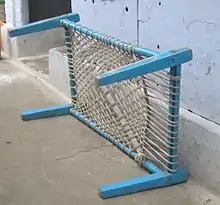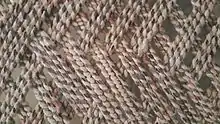Charpai
Charpai,[1] Charpaya, Charpoy, Khat or Manji (Hindi : चारपाई, Bengali: চারপায়া, Urdu: چارپائی, Saraiki, Punjabi; char "four" + paya "footed") is a traditional woven bed used across South Asia. Regional variations are found in Afghanistan and Pakistan, North and Central India, Bihar and Myanmar.[2] It is also known as khaat, khatia, or manji, and as manjaa in Punjab.


The charpai is mostly used in warm areas: its net is made out of cotton, natural fibers and date leaves. It is a simple design that is easy to construct. There are many interpretations of the traditional design and over the years craftspeople have innovated with the weave patterns and materials used.
It has a frame of four strong vertical posts connected by four horizontal members; the design makes the construction self-leveling. The weaving is done in many ways, e.g. a diagonal cross weave with one end left for adjustments as linear members, which helps in controlling the sagging of the bed as it ages with use. It was traditionally made out of a wooden frame and cotton ropes but modern charpais may have metal frames and plastic tapes.
Ibn Battuta describes the charpai as having "four conical legs with four crosspieces of wood on which braids of silk or cotton are woven. When one lies down on it, there is no need for anything to make it pliable, for it is pliable of itself."[3]
See also
References
- Susan Corinne Jamart (1978). Charpai: Indian Cot Filling, a Visual and Technical Documentation. University of California, Berkeley.
- "The Charpai Project asks you to take a seat for a ringside view of history". 26 Decenmber 2018. Check date values in:
|date=(help) - Battutah, Ibn (2002). The Travels of Ibn Battutah. London: Picador. pp. 185, 317. ISBN 9780330418799.
